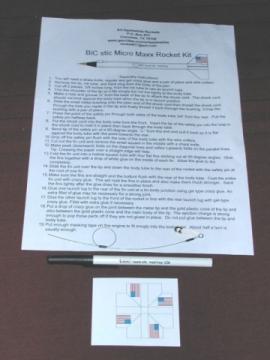Art Applewhite Rockets Micro Maxx BIC Stic
Art Applewhite Rockets - Micro Maxx BIC Stic {Plan}
Contributed by Dick Stafford
| Manufacturer: | Art Applewhite Rockets  |

(Contributed - by Dick Stafford - 05/10/02)
Brief:
This is yet another rocket based on a BiC® pen. Plans for other BiC®
rockets are available here on EMRR (BiC®
ARCAS and the
Double
Tree Pen Roc) and you can download the plan's for this one from Art
Applewhite's site. What you get here is a kit, with all the parts included.
Construction:
The following parts are provided in the kit: One BiC® pen, card stock with
the fin unit printed on it, a safety pin, and a shock tether assembly. The
latter is pretty neat. It appears to be a teeny-weeny braided steel cord with a
plastic covering. One end has a small loop closed with a crimp bushing. A
second loose bushing is provided to form a loop at the nose cone. To assemble
the kit you need a sharp knife, regular and Gel CA (I substituted Liquid Nails
for the latter), a pair of pliers, and wire cutters.
Assembly is really easy. You disassemble the BiC® pen, leaving only the empty tube. You remove the ink tube and shave the shoulder of the tip (i.e the nose cone) so it fits easily into the tube. One warning: the pen is full of ink and is thus potentially very messy. Over a couple of paper towels, I removed the ink tube and set it upright to drain. I also cleaned the ink from the tip and inserted a small piece of paper towel, wadded into a ball. This will keep any remnant ink from leaking out. The tether is attached by making a small hole in the shoulder of the nose cone, inserting the open end of the tether, and crimping on the bushing with a pair of pliers. The safety pin is used to punch a hole through the rear of the tube. You then pull the pin halfway out and feed the loop on the end of the tether over the tip. The pin is then reinserted, snipped off, and presto, you get a both a shock cord attachment and a motor block.
 Next, you cutout and fold the one-piece fin
unit, slide it onto the tube, and soak it in CA, which both holds it on and
strengthens it. Finally, you snip two small pieces from the ink tube and use
them for launch lugs. Make sure you save the rest for other Micro Maxx
projects.
Next, you cutout and fold the one-piece fin
unit, slide it onto the tube, and soak it in CA, which both holds it on and
strengthens it. Finally, you snip two small pieces from the ink tube and use
them for launch lugs. Make sure you save the rest for other Micro Maxx
projects.
Finishing:
No finishing is required.
Construction Rating: 5 out of 5
Flight:
No streamer material is provided nor is it needed. Prepping consists of
installing the nose cone and using masking tape for motor retention. The shock
cord is nice and sturdy, but it is also stiff, so it takes some effort to feed
it into the body tube. These Micro Maxx BiC® rockets really fly great. To
help spot this one I used a small amount of tracking powder. The first launch
flew and recovered nicely. On the second launch, however, it fell victim to a
rocket eating tree and was lost...temporarily. After a good wind that night, I
wandered over to look for it. To my joy and amazement, there it was! The nose
cone hadn't ejected, which kept it from getting hopelessly snagged in the tree.
Still, I guess I should quit using the open area down the street for my higher
flying Micro Maxx rockets. Bummer.
Flight Rating: 5 out of 5
Summary:
The resulting rocket looks nice and is a great flier. The 'fin unit' is nice
and the shock cord is cool. It is easy to build a similar rocket from existing
plans without a kit. However, it's hard to go wrong for only a couple of bucks.
Once you're ordering a flying saucer, go ahead and get one of these also.
Overall Rating: 5 out of 5
 |
 |
Flights
 |
 |
G.R. (March 18, 2009)
Sponsored Ads
 |
 |



![Calling Marshall Applewhite [Explicit] Calling Marshall Applewhite [Explicit]](https://m.media-amazon.com/images/I/51MeUaBWTkL._SL500_.jpg)








K.A.C. (July 17, 2005)